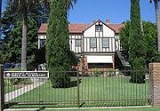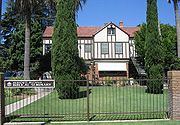
Canadian Conference of Mennonite Brethren Churches
Encyclopedia
The Canadian Conference of Mennonite Brethren Churches (CCMBC) is an association of Mennonite
Christian
s with origins in southern Russia
. It is part of the larger Mennonite Brethren Church and shares some common history with the US Conference of Mennonite Brethren Churches.
met in the village of Elisabeththal, Molotschna
on January 6, 1860, and formed the Mennonite Brethren Church. These brethren were influenced somewhat by the Moravian Brethren, and to a greater degree by Lutheran Pietism
through the influential preaching of Eduard Wuest. They felt the Mennonites had grown cold and formal, and were seeking greater emphasis on discipline, prayer and Bible study. The immediate catalyst for the new organization was the discipline placed on a body of brethren who met to observe communion in a private home without the elders' sanction.
From 1860 until 1872, the church grew from about 50 members to about 600. Mennonite Brethren were among the migration of nearly 18,000 Mennonites from Russia to North America
between 1874 and 1880. The members of the first migrations settled in the United States
, mainly in Kansas
, Minnesota
, Nebraska
, and South Dakota
. The first Mennonite Brethren congregation in Canada was founded in Winkler, Manitoba
in 1888 as a result of mission work from the United States.
From 1923 to 1929, almost 4500 Mennonite Brethren migrated from Russia to Canada
. More Mennonites came to Canada in the 1940s, mostly as a result of the events of war in Germany and Russia. These migrations greatly increased the number of Mennonite Brethren in Canada, and in 1945 a Canadian Conference was established. In 1954, the desire of the Canadian churches for independence brought about the formation of two area conferences of the Mennonite Brethren of North America — the subject of this article and the US Conference of Mennonite Brethren Churches.
; the Bible as the inspired word of God; the fall of humankind and salvation through the atoning work of Christ; the Lord's Day (Sunday) as a day of worship; and the resurrection of all people, either to eternal punishment or eternal life with God. The Mennonite Brethren Church holds two ordinances — baptism
and the Lord's supper. Water baptism by immersion is the mode administered by local congregations, but they may receive on confession of faith persons who have been baptized by other modes. Those baptized as infants must receive baptism from a local Mennonite Brethren congregation on their profession of faith. Believers who have confessed their faith in Jesus Christ and understand the meaning of the Lord's supper are invited to participate, though the Mennonite Brethren believe that baptism should precede participation in the communion service. Mennonite Brethren reject the swearing of oaths, membership in secret societies, and bearing of arms in warfare. The church allows alternative types of service during times of war.
 Currently (2010), there are Mennonite Brethren conferences in 19 countries. The largest conferences are located in India and the Democratic Republic of Congo. Offices of the Canadian Conference of Mennonite Brethren Churches are located in Winnipeg, Manitoba. In 2010, the Mennonite Brethren had 240+ congregations in Canada. The Mennonite Brethren support the Fresno Pacific University Biblical Seminary, with campuses in Fresno, California
Currently (2010), there are Mennonite Brethren conferences in 19 countries. The largest conferences are located in India and the Democratic Republic of Congo. Offices of the Canadian Conference of Mennonite Brethren Churches are located in Winnipeg, Manitoba. In 2010, the Mennonite Brethren had 240+ congregations in Canada. The Mennonite Brethren support the Fresno Pacific University Biblical Seminary, with campuses in Fresno, California
, Langley, British Columbia
, and Winnipeg, Manitoba. The Mennonite Brethren Herald is published monthly.
Mennonite
The Mennonites are a group of Christian Anabaptist denominations named after the Frisian Menno Simons , who, through his writings, articulated and thereby formalized the teachings of earlier Swiss founders...
Christian
Christian
A Christian is a person who adheres to Christianity, an Abrahamic, monotheistic religion based on the life and teachings of Jesus of Nazareth as recorded in the Canonical gospels and the letters of the New Testament...
s with origins in southern Russia
Russia
Russia or , officially known as both Russia and the Russian Federation , is a country in northern Eurasia. It is a federal semi-presidential republic, comprising 83 federal subjects...
. It is part of the larger Mennonite Brethren Church and shares some common history with the US Conference of Mennonite Brethren Churches.
Background
A small group of Mennonites in the UkraineUkraine
Ukraine is a country in Eastern Europe. It has an area of 603,628 km², making it the second largest contiguous country on the European continent, after Russia...
met in the village of Elisabeththal, Molotschna
Molotschna
Molotschna Colony was a Russian Mennonite settlement in what is now Zaporizhia Oblast in Ukraine. Today is called Molochansk with a population of under 10,000. The settlement is named after the Molochna River which forms its western boundary. Today the land mostly falls within the Tokmatskyi and...
on January 6, 1860, and formed the Mennonite Brethren Church. These brethren were influenced somewhat by the Moravian Brethren, and to a greater degree by Lutheran Pietism
Pietism
Pietism was a movement within Lutheranism, lasting from the late 17th century to the mid-18th century and later. It proved to be very influential throughout Protestantism and Anabaptism, inspiring not only Anglican priest John Wesley to begin the Methodist movement, but also Alexander Mack to...
through the influential preaching of Eduard Wuest. They felt the Mennonites had grown cold and formal, and were seeking greater emphasis on discipline, prayer and Bible study. The immediate catalyst for the new organization was the discipline placed on a body of brethren who met to observe communion in a private home without the elders' sanction.
From 1860 until 1872, the church grew from about 50 members to about 600. Mennonite Brethren were among the migration of nearly 18,000 Mennonites from Russia to North America
North America
North America is a continent wholly within the Northern Hemisphere and almost wholly within the Western Hemisphere. It is also considered a northern subcontinent of the Americas...
between 1874 and 1880. The members of the first migrations settled in the United States
United States
The United States of America is a federal constitutional republic comprising fifty states and a federal district...
, mainly in Kansas
Kansas
Kansas is a US state located in the Midwestern United States. It is named after the Kansas River which flows through it, which in turn was named after the Kansa Native American tribe, which inhabited the area. The tribe's name is often said to mean "people of the wind" or "people of the south...
, Minnesota
Minnesota
Minnesota is a U.S. state located in the Midwestern United States. The twelfth largest state of the U.S., it is the twenty-first most populous, with 5.3 million residents. Minnesota was carved out of the eastern half of the Minnesota Territory and admitted to the Union as the thirty-second state...
, Nebraska
Nebraska
Nebraska is a state on the Great Plains of the Midwestern United States. The state's capital is Lincoln and its largest city is Omaha, on the Missouri River....
, and South Dakota
South Dakota
South Dakota is a state located in the Midwestern region of the United States. It is named after the Lakota and Dakota Sioux American Indian tribes. Once a part of Dakota Territory, South Dakota became a state on November 2, 1889. The state has an area of and an estimated population of just over...
. The first Mennonite Brethren congregation in Canada was founded in Winkler, Manitoba
Winkler, Manitoba
Winkler is a small city with a population of about 9,900 located in southern Manitoba, Canada in the Rural Municipality of Stanley...
in 1888 as a result of mission work from the United States.
From 1923 to 1929, almost 4500 Mennonite Brethren migrated from Russia to Canada
Canada
Canada is a North American country consisting of ten provinces and three territories. Located in the northern part of the continent, it extends from the Atlantic Ocean in the east to the Pacific Ocean in the west, and northward into the Arctic Ocean...
. More Mennonites came to Canada in the 1940s, mostly as a result of the events of war in Germany and Russia. These migrations greatly increased the number of Mennonite Brethren in Canada, and in 1945 a Canadian Conference was established. In 1954, the desire of the Canadian churches for independence brought about the formation of two area conferences of the Mennonite Brethren of North America — the subject of this article and the US Conference of Mennonite Brethren Churches.
Status
The confession of faith of the Canadian Conference of Mennonite Brethren Churches (held in common with the US Conference) reveals the churches accept God in three persons; the divinity, humanity, virgin birth, atonement, resurrection, ascension, and return of JesusJesus
Jesus of Nazareth , commonly referred to as Jesus Christ or simply as Jesus or Christ, is the central figure of Christianity...
; the Bible as the inspired word of God; the fall of humankind and salvation through the atoning work of Christ; the Lord's Day (Sunday) as a day of worship; and the resurrection of all people, either to eternal punishment or eternal life with God. The Mennonite Brethren Church holds two ordinances — baptism
Baptism
In Christianity, baptism is for the majority the rite of admission , almost invariably with the use of water, into the Christian Church generally and also membership of a particular church tradition...
and the Lord's supper. Water baptism by immersion is the mode administered by local congregations, but they may receive on confession of faith persons who have been baptized by other modes. Those baptized as infants must receive baptism from a local Mennonite Brethren congregation on their profession of faith. Believers who have confessed their faith in Jesus Christ and understand the meaning of the Lord's supper are invited to participate, though the Mennonite Brethren believe that baptism should precede participation in the communion service. Mennonite Brethren reject the swearing of oaths, membership in secret societies, and bearing of arms in warfare. The church allows alternative types of service during times of war.

Fresno, California
Fresno is a city in central California, United States, the county seat of Fresno County. As of the 2010 census, the city's population was 510,365, making it the fifth largest city in California, the largest inland city in California, and the 34th largest in the nation...
, Langley, British Columbia
Langley, British Columbia (district municipality)
The Township of Langley is a district municipality immediately east of the City of Surrey in southwestern British Columbia, Canada. It extends south from the Fraser River to the U.S. border, and west of the City of Abbotsford...
, and Winnipeg, Manitoba. The Mennonite Brethren Herald is published monthly.
External links
- Official website
- The Mennonite Brethren Herald
- British Columbia Conference of Mennonite Brethren Churches
- Alberta Conference of Mennonite Brethren Churches
- Saskatchewan Conference of Mennonite Brethren Churches
- Manitoba Conference of Mennonite Brethren Churches
- Ontario Conference of Mennonite Brethren Churches
- US Conferences of Mennonite Brethren Churches
- Mennonite Brethren Biblical Seminary
- Mennonite Brethren Mission and Service International
- Canadian Conference of Mennonite Brethren Churches in Global Anabaptist Mennonite Encyclopedia Online (GAMEO)

